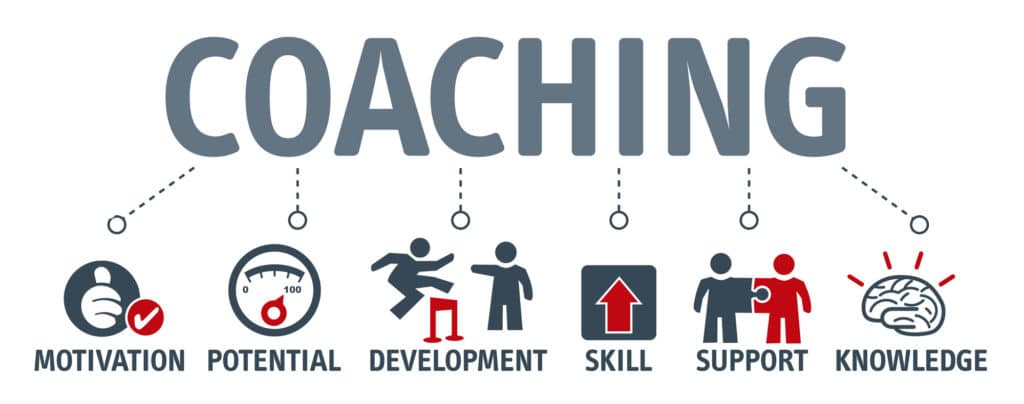Coaching Techniques for Managers
Great managers integrate coaching techniques into their management style – but may be challenged with creating a true coaching dynamic. Here’s how to address that.
It’s not news that adding coaching techniques to your management toolkit improves individual engagement and team performance. You’re probably reading this article because you already know that Gallup’s analysis of nearly 50,000 business units representing 1.2 million employees found that what makes a good manager is that they don’t “boss,” they “coach.” Great managers focus on individual and team engagement, set clear expectations and performance goals, while offering feedback, and optimize for unique talents and strengths of each employee, leading to increased sales and profit, (Robinson, 2020). There are loads of articles out there about why manager coaching skills can level-up your management style. But, a manager who takes a coaching approach is not the same as a coach. Why is that, and what can you do about it? Hint: It comes down to how invested you are in your team’s success, and being aware of how that can contribute to conflict of interest in a coaching conversation.
Manager Coaching Skills
Two key characteristics of a coaching engagement are that 1) the coach and coachee are in an equal partnership, and 2) the coachee is responsible for the outcomes.
Let’s start with a quick overview of what makes coaching stand on its own among other fields in self-development. Coaching has a core set of principles and approaches (which differ slightly across coaching schools and organizations) that come down to the belief that the person being coached, not the coach, is responsible for the outcomes.
In her book, Coaching Skills: A Handbook, Jenny Rogers writes, “Coaching is the art of facilitating another person´s learning, development, well-being and performance. Coaching raises self-awareness and identifies choices. Through coaching, people are able to find their own solutions, develop their own skills, and change their own attitudes and behaviours.” She goes on to define six principles of coaching:
- The client is resourceful.
- The coach’s role is to help the client to develop this resourcefulness.
- Coaching addresses the whole person.
- The client sets the agenda.
- The coach and the client are equals.
- Coaching is about change and action.
The person being coached is capable of, and should be the one, proposing and producing their own reflection, experiments, changes, and results. The coach is an equal partner walking alongside the coachee. The coach builds trust and offers a safe and judgement free environment. The coach listens, asks powerful questions, makes observations, and may at times offer guidance (which the coachee can take or leave as they decide).
Even the most mindful, aware, and intentional manager may find themselves struggling to remain neutral in a coaching conversation, as they are ultimately responsible for their team’s output and performance.
Managing Direct Reports
In general, managers can partner with direct reports in a number of ways, and can create conditions for fair and equal treatment of employees. However, as the manager, you are also responsible for team output and performance. That responsibility gives you the power to direct, delegate, and decide. It also means you are invested in arriving at or achieving specific outcomes.
In other words, managers have a vested interest in how direct reports are impacted by management and coaching conversations. This investment and shared responsibility in the outcome creates the potential for conflicts of interest. (In fact, the International Coaching Federation will not allow coaches submitting applications for credentials to count “coaching hours” with direct reports for this very reason).
What could this conflict of interest look like in action?
- You may project other team feedback or insights into coaching questions or observations, unintentionally managing direct reports instead of letting them take the lead
- You may struggle to balance your own sense of urgency with letting the direct report set the agenda and drive their own development, especially in regards to performance coaching
- You may be keyed into “solution mode,” wanting to unblock and unlock potential paths forward for your direct report
- You may not be able to step back and listen objectively when the direct report presents challenges or issues, especially where you have additional insight or perspective or are in some way involved
- Your investment in team dynamics may affect your ability to fully empathize with their direct report’s experience and tempt you to step outside of the role of a coach into the role of a mediator
- Your direct report may be hesitant to fully disclose challenges and/or career aspirations with you, knowing that you are responsible for assessing their work performance
- Your direct report may resist discussing aspects of their working relationship you, and/or you may not be able to remain neutral or non-reactive in the case that the direct report does bring something up
These are just a brief glimpse at the ways in which the shared responsibility for work outcomes may impact how a manager and direct report approach “coaching outcomes” together. Think about what it would be like to have a coaching conversation with the people on your team – either your direct reports or your own manager – and consider… what would you add to this list?
This doesn’t mean all hope is lost if you want to coach your direct reports. What techniques can you use to stay grounded and neutral?
What is the difference between coaching and managing?
First, learn about the differences between management and coaching and get very clear on what a coaching interaction looks like. Read up on coaching techniques and practice having coaching conversations with trusted colleagues or friends. Try working with a professional coach where you can see coaching modeled, and get used to the pace and feel of a coaching conversation with someone trained in this skillset.
Next, talk with your direct reports about your ideas for what it could look like to integrate coaching into your management style. Don’t surprise anyone with full-on socratic interrogations in their next one on ones! Let your team know how the conversation mechanics might shift in a coaching conversation.
For example, in “coach mode,” they may only hear questions or observations (vs. advice or solutions) and they’ll be expected to come up with their own action items moving forward. Ask for their feedback. What do they think coaching can do for them or for the team? If you’ve already been testing or refining coaching approaches alongside your management strategy, use this as an opportunity to check in and gather even more specific feedback on what is working, and where you could continue to grow.
Finally, always make people aware when you’re stepping into the role of a coach. Whether taking a more formal approach and scheduling specific times for coaching, or more casually integrating coaching into opportune moments in everyday meetings and conversations, always be sure the person on the other side knows that the “coach hat” is going on or “coaching lens” is coming out. Hopefully, since you’ve already spoken with the team and established that you’re going to be exploring coaching, everyone will be on the same page about what it means when you make the switch into “coach-mode.”
When you do switch into coach mode, take a moment to get grounded and remind yourself of who you are as a coach. Remember that you’re committing to questioning and observations. Resist the urge to mentor, consult, or provide advice (which, where power dynamics are at play, can end up overshadowing the coachee’s own reflection and decision making process).
If you do find yourself slipping into ideation or suggestion mode, be very clear that these are not plans of action you expect your direct report to take. Wrap up each conversation by asking for your direct report’s key takeaways. Listen intently and trust that what they’re taking from the conversation is what they need to take away from it. Continue to gather feedback about how the people on your team feel about these coaching interactions.
It’s ok if you can’t always untangle management from coaching. No one is perfect!
Don’t be hard on yourself if some days you’re better at staying in coach-mode than others. You’re human – and no matter how much you practice self-awareness in leadership and refine your coaching technique, there will simply be times that your own interests, emotions, or circumstances will show up and interrupt your best intentions to stay neutral and take an objective stance in a coaching conversation. Even a “coach and coachee” relationship without the added element of management is not a perfectly equal dynamic either.
Professional coaches have hundreds of hours of training and ongoing development in their craft, and even then, they must stay actively aware of how conflict of interest or power may show up in their relationships with their coachees. Every person, every situation, every challenge, every coaching request, is different. By integrating coaching approaches into your toolkit, you’re taking your management skills to the next level. That’s something to be proud of, even when it’s not perfect.
Want to take the results of coaching a step further? Consider formally adding coaching to your employee development plan.
As you continue to build coaching skills for leaders and managers into your strategy, there is one obstacle that you might find standing in your way when it comes to direct reports getting the most out of coaching: you can only control your behavior when applying coaching techniques. You will always be the manager when having coaching conversations, and that may limit what direct reports feel comfortable bringing to the table. As you start to see the benefits of coaching, you might also consider adding internal or external coaching into your employee development plan.
If your company is interested in developing an internal coaching function, be sure to put clear roles, processes, and confidentiality policies in place that protect the coachee and coach where conflicts of interest could arise. Or, you may consider a leadership coaching firm like Lingo Live, where you can leverage the knowledge and processes of a professional coaching organization to ensure that your direct reports are placed with trained, qualified, vetted and ethically sound coaches who can cultivate an equal partnership and safe and trusted space for your employee to work on their skills and personal development. Feel free to reach out to us to learn more about how you can craft a leadership coaching solution for your team or organization’s needs.
Sources
In S. Palmer & A. McDowall (Eds.) The Coaching Relationship: Putting People First, London: Routledge, pp. 139-158.
Robinson, Jennifer. “Give Up Bossing, Take Up Coaching: You’ll Like the Results.” 17 January, 2020.
Give Up Bossing, Take Up Coaching: You’ll Like the Results – By Gallup
Rogers, Jenny (Jennifer). “Coaching Skills: a Handbook.” Maidenhead, Berkshire : Open University Press, 2004.
About the Author



